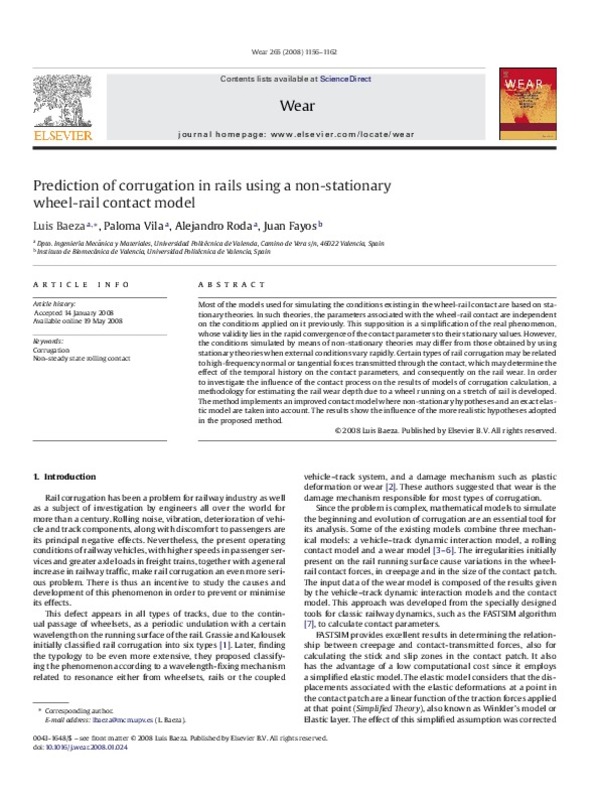JavaScript is disabled for your browser. Some features of this site may not work without it.
Buscar en RiuNet
Listar
Mi cuenta
Estadísticas
Ayuda RiuNet
Admin. UPV
Prediction of corrugation in rails using a non-stationary wheel-rail contact model
Mostrar el registro sencillo del ítem
Ficheros en el ítem
| dc.contributor.author | Baeza González, Luis Miguel
|
es_ES |
| dc.contributor.author | Vila Tortosa, María Paloma
|
es_ES |
| dc.contributor.author | Roda Buch, Alejandro
|
es_ES |
| dc.contributor.author | Fayos Sancho, Juan
|
es_ES |
| dc.date.accessioned | 2018-01-16T09:53:38Z | |
| dc.date.available | 2018-01-16T09:53:38Z | |
| dc.date.issued | 2008 | es_ES |
| dc.identifier.issn | 0043-1648 | es_ES |
| dc.identifier.uri | http://hdl.handle.net/10251/94884 | |
| dc.description.abstract | [EN] Most of the models used for simulating the conditions existing in the wheel-rail contact are based on stationary theories. In such theories. the parameters associated with the wheel-rail contact are independent on the conditions applied on it previously. This supposition is a simplification of the real phenomenon, whose validity lies in the rapid convergence of the contact parameters to their stationary values. However, the conditions simulated by means of non-stationary theories may differ from those obtained by using stationary theories when external conditions vary rapidly. Certain types of rail corrugation may be related to high-frequency normal or tangential forces transmitted through the contact, which may determine the effect of the temporal history on the contact parameters, and consequently on the rail wear. In order to investigate the influence of the contact process on the results of models of corrugation calculation, a methodology for estimating the rail wear depth due to a wheel running on a stretch of rail is developed. The method implements an improved contact model where non-stationary hypotheses and an exact elastic model are taken into account. The results show the influence of the more realistic hypotheses adopted in the proposed method. (C) 2008 Luis Baeza. | es_ES |
| dc.language | Inglés | es_ES |
| dc.publisher | Elsevier | es_ES |
| dc.relation.ispartof | Wear | es_ES |
| dc.rights | Reserva de todos los derechos | es_ES |
| dc.subject | Corrugation | es_ES |
| dc.subject | Non-steady state rolling contact | es_ES |
| dc.subject.classification | INGENIERIA MECANICA | es_ES |
| dc.title | Prediction of corrugation in rails using a non-stationary wheel-rail contact model | es_ES |
| dc.type | Artículo | es_ES |
| dc.identifier.doi | 10.1016/j.wear.2008.01.024 | es_ES |
| dc.rights.accessRights | Abierto | es_ES |
| dc.contributor.affiliation | Universitat Politècnica de València. Departamento de Ingeniería Mecánica y de Materiales - Departament d'Enginyeria Mecànica i de Materials | es_ES |
| dc.description.bibliographicCitation | Baeza González, LM.; Vila Tortosa, MP.; Roda Buch, A.; Fayos Sancho, J. (2008). Prediction of corrugation in rails using a non-stationary wheel-rail contact model. Wear. 265(9):1156-1162. doi:10.1016/j.wear.2008.01.024 | es_ES |
| dc.description.accrualMethod | S | es_ES |
| dc.relation.publisherversion | https://doi.org/10.1016/j.wear.2008.01.024 | es_ES |
| dc.description.upvformatpinicio | 1156 | es_ES |
| dc.description.upvformatpfin | 1162 | es_ES |
| dc.type.version | info:eu-repo/semantics/publishedVersion | es_ES |
| dc.description.volume | 265 | es_ES |
| dc.description.issue | 9 | es_ES |
| dc.relation.pasarela | S\33424 | es_ES |








